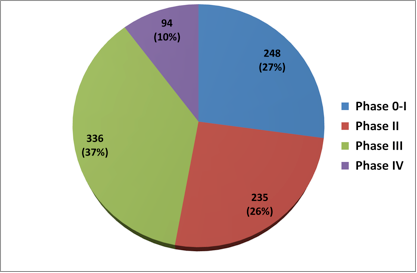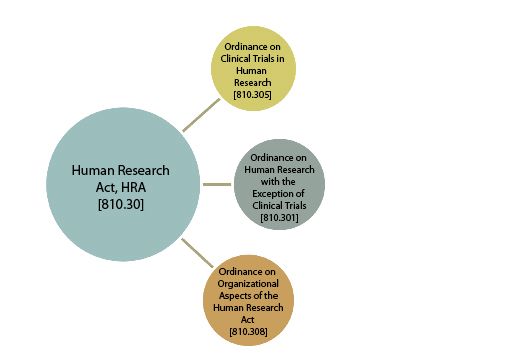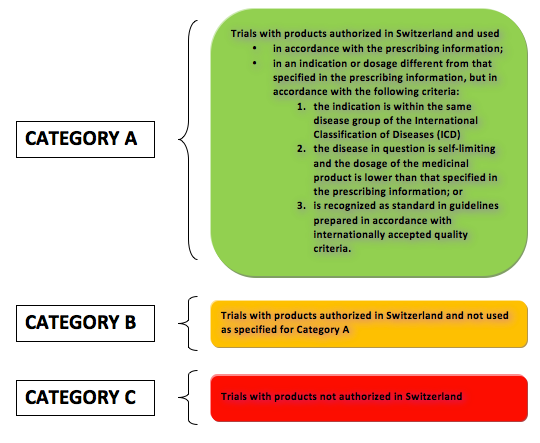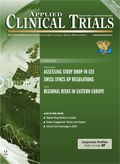Switzerland Guides Innovation in Clinical Trial Regulations
Applied Clinical Trials
The country’s introduction of a new legal framework has it in sync with European law on clinical research.

Will the recently released European clinical trial regulation No. 536/2014 achieve its ambitious harmonization objectives? We will have to wait at least until 2016 to find out. But for the moment, something is already happening in the very heart of Europe … Switzerland. Switzerland is a country small in size, but big in innovation that has always been an attractive location for clinical trials.
From 2010 to 2013, approximately 200 to 250 clinical trials a year were approved in Switzerland6 and only a negligible number (1.5%) were rejected.

Figure 1: Number of clinical trials approved in Switzerland 2010-2013
Until last year, the main regulation for clinical trials in Switzerland was the law Vklin/Oclin 812.214.2, released in 2001. This was a brief—but wide purpose—document describing the key procedures and requirements for submitting and conducting a clinical trial in Switzerland, including safety reporting, archiving, ethics committee organization, inspections, and administrative procedures.
A clinical study application started with the ethics committee approval and was followed by the central national authorities review (Swissmedic or Swiss Agency for Therapeutic Products; hereafter referred to as “Agency”) in a sequential, two-step process.
Even if the purposes of the ethics committee and Agency reviews were in principle different, a certain extent of duplication in the evaluation was still present and led to conflicting comments at times.
Harmonization of existing regulations
Switzerland now has a new rational, properly organized set of regulations governing most aspects of human research, including those that were loosely regulated before. One general regulation and three implementing ordinances greatly increased clarity and understanding of the requirements and procedures for carrying out a research project in Switzerland.
On Sept. 30, 2011, the Swiss Confederation approved the new federal law on research on human being—the Human Research Act, HRA [810.30].1 This law aims at improving the protection of the dignity, privacy, and health of human beings involved in research and at the same time:
- Creating favorable conditions for research involving human beings
- Ensuring the quality of research
- Ensuring the transparency of research
The law regulates the research on human diseases and on the structure and function of the human body, which involves:
- Persons
- Deceased persons
- Embryos and fetuses
- Biological material
- Health-related personal data
In vitro research involving embryos, research on anonymized biological material or on anonymously collected or anonymized health-related data were excluded from the purposes of the law.
On Sept. 20, 2013 the Swiss Confederation approved the HRA-associated implementing ordinances:
- Ordinance on Clinical Trials in Human Research2
This ordinance describes the procedure for approval and notification of clinical trials as well as the specific role and responsibilities of the ethics committees and central authorities.
- Ordinance on Human Research with the Exception of Clinical Trials3
This ordinance describes the procedure for approval and notification of research projects that are not clinical trials (e.g., observational studies, research on deceased persons, studies with biological material and health-related personal data, etc.)
- Ordinance on Organizational Aspects of the Human Research Act4
This ordinance mainly describes the organization of ethics committees.
The new legislation entered into force on Jan. 1, 2014.

Figure 2: Overview of the new Swiss regulations
According to the Swiss Federal Council, "The Human Research Act [...] sets a new framework for research on humans and establishes clearer, simplified procedures for approving and conducting research projects. The new law also makes it easier to conduct clinical studies over several locations."5
Only the most relevant innovations will be summarized in this article, limiting the discussion to trials with therapeutic agents.
Parallel submission
As discussed, with the previous regulation, the evaluation of trials by the local ethics committees and the central authority was performed sequentially. This process (double-control principle) was time consuming and not always the most efficient.
With the new procedure, a parallel submission can be performed. The specific and different area of competence of local ethics committees and the Agency has been clearly defined, avoiding relevant duplication.
The ethics committees are mainly responsible for the evaluation of good clinical practice (GCP) compliance, scientific value, inclusion criteria, risk/benefits, ethical aspects of the trial, protection of study participants, consenting procedures, study insurance, contractual agreements, suitability of study personnel, and facilities.
The Agency, depending on the type of trial, is mainly responsible for the evaluation of the safety of tested drugs for study subjects (for trials with therapeutic agents), including review of clinical pharmacology, toxicological, pharmacokinetical data, and all pre-clinical information, GMP compliance if applicable, and product quality.
In addition to the added clarity, this new parallel submission allows a considerable shortening of the evaluation process.
Assuming that the documents of the application are complete and no additional information is needed, the ethics committee and the Agency could reach a decision within 30 days, plus an initial seven days for validation and control of compliance of the application documents. Previously, the sequential evaluation of the application could add up to at 60 days (30 days for each party).
For multicenter clinical trials, the coordinating investigator (the person responsible in Switzerland for coordination of the investigators responsible at the individual trial sites) will submit the application documents to the lead committee. After control of formal completeness of the application, at the request of the lead committee, the coordinating investigator shall submit the required application documents to the ethics committees responsible at the other trial sites. These shall review the local conditions and inform the lead committee of their assessment within 15 days. The lead committee shall reach a decision within 45 days of acknowledgement of receipt of the formally correct application.
Risk classification of medicinal products research projects
One of the most relevant innovations of the new regulation is a three-level system of classification of research projects based on anticipated risk of projects.
Category A research projects are lower risk and involve medicinal products already authorized in Switzerland used in accordance with the prescribing information or with a different dosage or indication but in the same disease group and with a lower dosage.
Category B research projects are intermediate risk and include medicinal products already authorized in Switzerland used beyond the indications of Category A.
Category C research projects are higher risk medicinal products not authorized in Switzerland.
See Figure 3 for additional details.

Figure 3: Categorization of clinical trials of medicinal products (art. 19 of Swiss Ordinance on Clinical Trials in Human Research).
A similar and simplified classification (two categories) was also introduced in trials with medical devices.7
The classification of trials according to their risk is the foundation of a tailored and optimized evaluation procedure. Lower-risk studies benefit from exemption from Agency evaluation and could benefit from reduced liability coverage requirements as well as lower documentation burden for adverse event documentation. For lower-risk trials, a simplified ethical review of the application has also been introduced.
Clinical trials register
One of the most relevant aspects of the new EU Clinical Trials Regulation is the attention paid to the transparency of clinical trials, with the introduction of a public central database developed by the European Medicines Agency (EMA). Study milestones, a summary of the trial results, a summary for laypersons, and the clinical study report (when the trial is intended to be used for obtaining a marketing authorization) will have to be submitted in the database.
The underlying assumption of the European regulators is that, in principle, the data of clinical trial reports should not be considered commercially confidential.8
This concept is very much debated by the industry, with important concerns expressed over data protection and disclosure of commercially relevant information.
Switzerland, with the new regulation, has also created an independent portal for public access to information on ongoing and completed trials in the country—the Swiss National Clinical Trials Portal (SNCTP).9
The registration in the database should be integrated with the additional entry in existing registers, such as those listed by the World Health Organization (WHO) in the International Clinical Trials Registry Platform (ICTRP)10 or the registry of the U.S. National Library of Medicine.11
The registration should occur before the clinical trial is conducted.
Phase I trials with adults must also be registered, however, a one-year exemption after the completion of the clinical trial has been granted, in order to protect sponsors' intellectual property.
SNCTP aims to make information on clinical trials in Switzerland more accessible to the public (data shall be entered in one of the Swiss national languages) and in the end, more transparent. However, the extent of disclosure, especially of study results, is more limited than it will be probably required in Europe when the new EU regulation will be fully operative.
Organization of research ethics committees
The new regulation introduces important changes for research ethics committees, with modification of both their organization (with the introduction of scientific secretariats) and their procedures.
The ethics committees will take their decision in the following three different modalities:
- Regular procedure: This is the normal procedure, with participation of at least seven members with different expertize to guarantee an expert and interdisciplinary assessment of the application.
- Simplified procedure: Under this procedure, only three members from different disciplines are required. This procedure will be generally applied to category A clinical trials and research projects or for the evaluation of significant changes to authorized research projects, if they raise particular ethical, scientific, or legal issues.
- Decisions by the chair: A decision directly taken by the chair or vice-chair of the ethics committee on minor issues, such as research projects involving existing biological material, or existing health-related personal data, or significant changes to authorized research projects which do not raise any particular ethical, scientific, or legal issues.
Conclusions
Switzerland has introduced a new, advanced legal framework of regulations for clinical research. The foundation of the new system is the introduction of a risk-based system that will decrease and rationalize the bureaucratic burden of research. This approach is in line with the recommendations of the Organization for Economic Co-operation and Development (OECD) in its recent document "Recommendation of the Council on the Governance of Clinical Trials" that suggests introducing a risk-based "proportionate regulatory approach."12
Shortly after the implementation of the Swiss laws, Europe has finally published its new clinical trial regulation. While drafting its rules, Switzerland reviewed the changes in European legislation, proceeded in the same direction, and anticipated some of its innovations. This effort will continue once the European regulation is implemented.
While the challenges of the application of a single regulation for human research across Europe still have to be faced, Switzerland is already benchmarking with success many of the same key principles. The paths of European and Swiss human research are leading in the same direction. It is not easy to speculate about the extent of harmonization that will be reached, since this will depend upon both technical and political agreements.
Performing trials in Switzerland still remain advantageous for sponsors due to the country’s high standards of research, excellence of clinical sites, minimal, no-nonsense bureaucracy, and now, with the new regulations, even faster and effective regulatory approvals.
Mario E. Corrado is Quality Assurance Manager, CROss Alliance Group, [email protected]
References
- Federal Act on Research involving Human Beings (Human Research Act, HRA), 810.30; http://www.admin.ch/ch/e/rs/810_30/index.html#id-ni1; [last accessed September 2014].
- Ordinance on Clinical Trials in Human Research (Ordinance on Clinical Trials, ClinO), 810.305; http://www.admin.ch/ch/e/rs/8/810.305.en.pdf ; [last accessed September 2014].
- Ordinance on Human Research with the Exception of Clinical Trials (Human Research Ordinance, HRO), 810.301; http://www.admin.ch/ch/e/rs/8/810.301.en.pdf; [last accessed September 2014].
- Ordinance on Organizational Aspects of the Human Research Act (HRA Organization Ordinance, OrgO-HRA), 810.308; http://www.admin.ch/ch/e/rs/8/810.308.en.pdf; [last accessed September 2014].
- https://www.news.admin.ch/message/index.html?lang=en&msg-id=51455; ; [last accessed September 2014].
- Data from Swissmedic Clinical Trials Division.
- 810.305 Swiss Ordinance of 20 September 2013 on Clinical Trials in Human Research (Clinical Trials Ordinance; ClinO); http://www.admin.ch/opc/en/classified-compilation/20121176/index.html;[last accessed May 9th, 2014]
- http://www.ema.europa.eu/ema/index.jsp?curl=pages/news_and_events/news/2014/10/news_detail_002181.jsp [last accessed October 2014].
- http://www.kofam.ch/en/swiss-clinical-trials-portal.html; [last accessed September 2014].
- http://www.who.int/ictrp/en/ ; [last accessed September 2014].
- http://www.clinicaltrials.gov/; [last accessed September 2014].
- http://acts.oecd.org/Instruments/ShowInstrumentView.aspx?InstrumentID=281&InstrumentPID=304&Lang=en&Book=; [last accessed September 2014].
